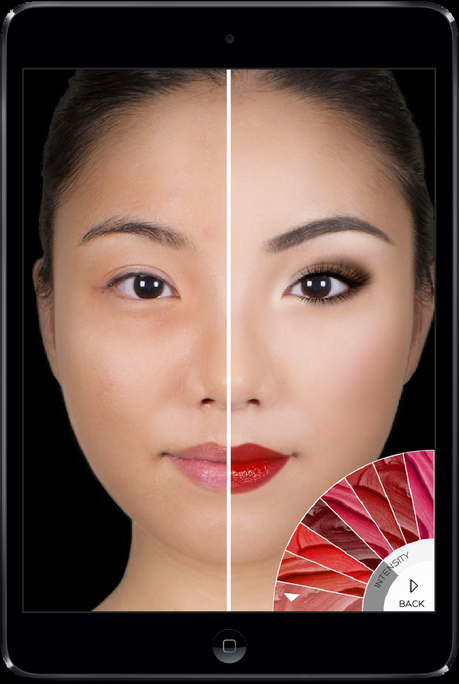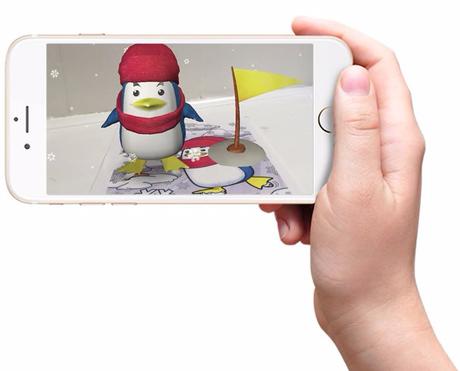As technology advances, we inch closer to the hybrid reality envisioned by sci-fi authors in the last century, a reality in which technological augmentations are as expected and accepted as our phones and laptops today. Augmented reality is becoming increasingly more common a medium, and is seeping into our lives across many industries. There are many ways AR is used to augment our worlds, and in this post I’ll explore what I see as the three key pillars of augmented reality: augmenting humans, augmenting creativity, and animating the inanimate.
Augmenting Humans
When we think of augmented reality, one of the first places our minds jump is adding digital elements into our physical worlds, like the skyscraper-sized 3D ads in Ghost in the Shell. But in today’s world, AR is more commonly used on an individual level to augment ourselves. A prime example of this in action? Modiface‘s makeup app for Sephora.
 Credit: Modiface
Credit: Modiface
Modiface is not the only company to use AR to convey a digital try-on effect. The Gap is launching an AR dressing room app to allow users to visualize the catalog of clothing in 3D in their own space:
 Credit: The Gap
Credit: The Gap
As this technology evolves, we will begin to see more and more retailers embracing this approach and integrating it into the online shopping experience – if you know exactly how something will look on your body without needing to see the garment in person, you don’t need to go to a store to try it on! If this is adopted, it could be the death of the brick-and-mortar store as we know it.
But of course, augmenting humans goes beyond retail applications. In fact, many of us use it on a lightweight scale every day with Snapchat (and now Instagram’s) face mapped filters.
Augmenting Creativity
Another way that AR is augmenting our worlds is by augmenting our creative processes. The beautiful thing about technology is that it is not bound by the same limits of physics that we are in the tangible world – augmented reality enables us to create the impossible with digital elements. Actiongram, an app for HoloLens, is a great example of how creators can use digital elements to build mixed reality media stories and videos. This creation style is being used by artists, videographers, and musicians to create cool mixed experiences in a way that feels more organic, less polished. Another example of this is Quiver AR, an app that brings colouring pages to life with augmented 3D characters.
 Credit: Quiver AR
Credit: Quiver AR
Animating the Inanimate
My first exposure to the concept of AR was the holographic chess in Star Wars. By adding contextual augmentations, “looking into” objects (rendering their innards), or even having the objects themselves come alive, we bridge the gap between the digital and physical and approach a hybrid reality.
This pillar is one of the reasons AR is becoming such an enriching tool for education. Take a look at how Case Western Reserve University is using the HoloAnatomy app for HoloLens to augment medical education:
The Fitzwilliam Museum in Cambridge recently announced their new AR app, which features the founder of the museum taking users on a guided tour of the museum’s art exhibits, back in time through history. The app brings the museum to life in a new way and reinvigorates the process of exploring history with technology.
Animating the inanimate doesn’t necessarily mean adding talking characters or 3D models, it can be as simple as adding rich context to objects and locations. At IO this week Google debuted Lens, their latest AR solution, which does exactly this, on the go. It’s not clear yet when this functionality will be available to users, but it does pretty much what we wanted Google Glass to do, but from the comfort of your smartphone:
With Google Lens, your smartphone camera won’t just see what you see, but will also understand what you see to help you take action. #io17 pic.twitter.com/viOmWFjqk1
— Google (@Google) May 17, 2017
As we move into a more technologically-dependent future, the lines between real and virtual will become very blurry, and more pillars of AR will emerge. Haptics and other sensory information will come into play and one day the notion of digitally-enhanced environments will become as ubiquitous and essential as our smartphones are today. One day, augmented reality will just be reality – or, you might say, it’s the other way around.
. . . . . . .





